Lacombe: Central Alberta’s Biggest Sports Attraction 1950-1988
By Robyn Jensen
“It’s like playing in the World Series and the All-Star game wrapped into one...You grow up in Central Alberta watching and hearing of the tournament and wanting to play in it.” (Blair Hanna, Red Deer and Lacombe star) (Danny Rode column, Red Deer Advocate 21 Jun 1988, Pg.6)

Lacombe is a city of about 13,000 in central Alberta, but in the 1950s, it was a smaller community of only 2,200 people. It is known for having one of 20 agricultural research stations in Canada focusing on crop and livestock production and where the Lacombe Hog was bred.
But history seems to have forgotten that almost 75 years ago, Lacombe hosted some of the most impressive baseball tournaments in Western Canada. It attracted teams from the United States and beyond to compete for a sizable amount of prize money. It also brought an exciting pool of Major League Baseball (MLB) scouts looking for the next big talent. The tournament quickly became one of the season's highly anticipated events for fans and players alike. Organized by the local Lacombe Lions Club, it ran annually for a notable 39 years and was put on hold until a new home was found after the local junior high school was built on the old ballpark. (Lacombe - County, City, Community, Pg. 195)
This is the story of the tournament’s first three years and how the Lions, with the unwavering support of the local community, created one of the biggest and best ball tournaments in Western Canada. It was a collective effort, a testament to the community's love for the game and their determination to make the tournaments a success. This was not just a tournament, but a symbol of the community's spirit and unity, a forerunner of modern tournament play.Why Tournaments?
Baseball, a beloved pastime in small communities across Canada and on the prairies, was more than just a game. It was a way for people to come together, to share laughter and competition. When the stakes increased, communities and towns united for a day or weekend of spirited tournaments. As baseball became more popular, so did the expectations, and hunting for better players to compete also became a desired endeavour.
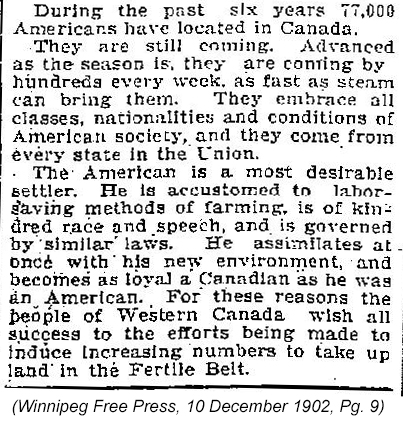 The Dominion of Canada actively encouraged Americans to purchase land in the 19th century, particularly for farming. Their knowledge and passion for baseball were also brought to the prairies.
The Dominion of Canada actively encouraged Americans to purchase land in the 19th century, particularly for farming. Their knowledge and passion for baseball were also brought to the prairies.
The 1902 edition of the Winnipeg Free Press reported that 77,000 Americans had moved to Canada since 1895.
The excitement for the game spread like wildfire, fueled by the accounts of major league games with the expansion of printed media (newspapers) in the late 19th and early 20th century. This laid the foundation for the early MLB fan bases in small communities and cities. The local enthusiasts flocked to the telegraph office when the paper wasn’t swift enough to deliver the game results. They stood in a crowd, their ears focused on the rhythmic pattern of the “click, click, click” and waiting for the operator to decipher it. Telegrams served as the first text-to-text messaging system (a precursor to our modern texting) to transmit messages faster through an electric telegraph line. And finally, with the advent of the radio, the sounds and game commentary were beamed directly into the living rooms, revolutionizing how people experienced baseball. This influenced the expectations of the ball fans when they went to games in person, hoping to match or exceed the experience they had reading or listening.
This baseball fever attracted many players from the United States, who traveled to Western Canada with barnstorming teams to showcase their talents further. By doing so, they expanded the sport’s reach to areas without professional teams and earned extra money, as most ball players were not well-paid back then. Barnstorming also allowed Black players to play and earn money when they were boycotted from the major leagues. This segregation was due to the ‘colour line’ drawn by the National Association of Baseball Players in 1867.
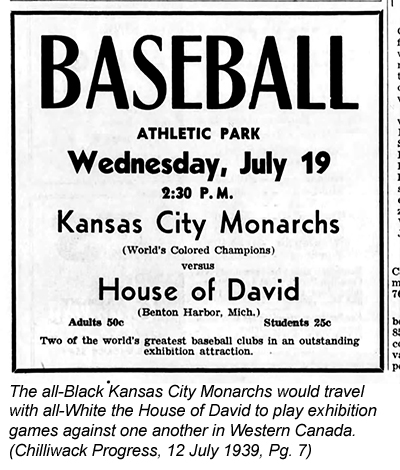 Because barnstorming was not part of the sanctioned games by the association, there were no rules against mixing players from different racial backgrounds to compete against each other. During this period, barnstorming tours often featured games between white major leaguers and teams from the Negro Leagues or mixed-race teams, offering fans a chance to see matchups that were not possible in the segregated major leagues.
Because barnstorming was not part of the sanctioned games by the association, there were no rules against mixing players from different racial backgrounds to compete against each other. During this period, barnstorming tours often featured games between white major leaguers and teams from the Negro Leagues or mixed-race teams, offering fans a chance to see matchups that were not possible in the segregated major leagues.
Communities and cities on the prairies, particularly Saskatchewan, started understanding the benefits of adding Black talent to their rosters. In 1927, John Donaldson worked as a freelance pitcher and played in Moose Jaw, SK. These teams were working outside the codes and rules of pro ball and the provincial amateur restrictions of the day, commonly referred to as outlaw ball. (Dave Shury, Bigotry on the Prairies, 1985, Jay-Dell Mah and Rich Necker)
It became evident that the communities hosting these events were a major draw. Furthermore, it was an additional attraction if some of these players were nabbed to play on the local teams, Whites and Blacks included (to heck with the ‘colour-line’). Many talented Negro League players made their way to Canada to play on prairie teams. As one 1950s pitcher from the Kamsack Cyclones, John Zeeben shared, “We were just a bunch of bush league players until the Negro League talent came up. We learned so much from them.” (Robyn Jensen interview with John Zeeben, 2023)
After World War II, towns and cities were attracting thousands of people, becoming a significant source of fundraising income for local community groups and support for businesses. This economic impact underscored the importance of baseball in the region's history and development.

Along comes Lacombe
The story goes that after seeing the Lloydminster Baseball Tournament in 1949, Jack Ferris, a former president of the Lacombe Lions Club, convinced his colleagues to hold a tourney in Lacombe. The inaugural event was staged June 20-21, 1950, with prize money of $3,750. (That’s worth about $50,000 in 2024 money.) It's an impressive amount to attract a good pool of teams for their first year.
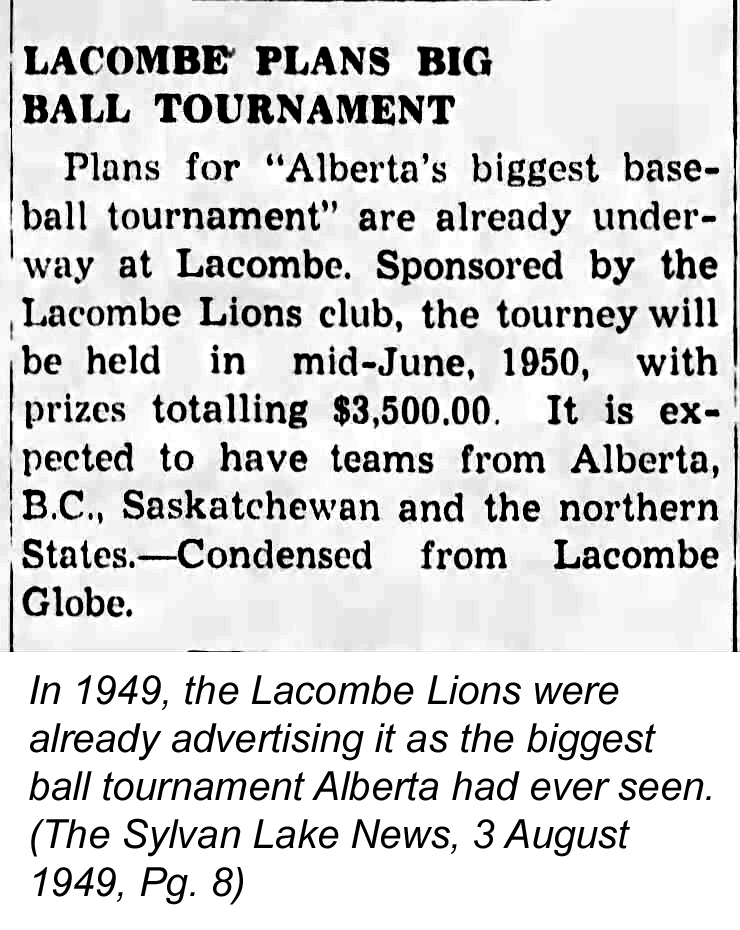
The first Lacombe Tournament, as reported by The Lacombe Globe on June 15, 1950, was billed as "Central Alberta's biggest summer attraction." Final preparations were nearly complete, and tournament chairman Jack Ferris confirmed everything was ready for the opening games at 9 a.m. Tuesday morning.
The event featured big names in baseball, with teams such as the Indian Head Rockets, a new All-Black baseball team from Jacksonville, Florida, and the Ladd Field U.S. Airforce Alaska Command team, who had performed well in the American baseball tournament at the New York Polo Grounds. The tournament included notable hockey players from the Sceptre team, one being Metro Prystai of the Chicago Black Hawks. Alongside the games, the event featured an aerial display by the R.C.A.F., a simulated battle by the Calgary Tank Regiment, public dances, and an industrial exhibition. The Edmonton Chamber of Commerce sponsored a "cavalcade of goodwill," and the town declared June 21st a civic holiday. The California Mohawks and Sceptre split the first prize money when rain prevented the championship game, and various exciting matches and local attractions made the tournament a resounding success. (attheplate.com)
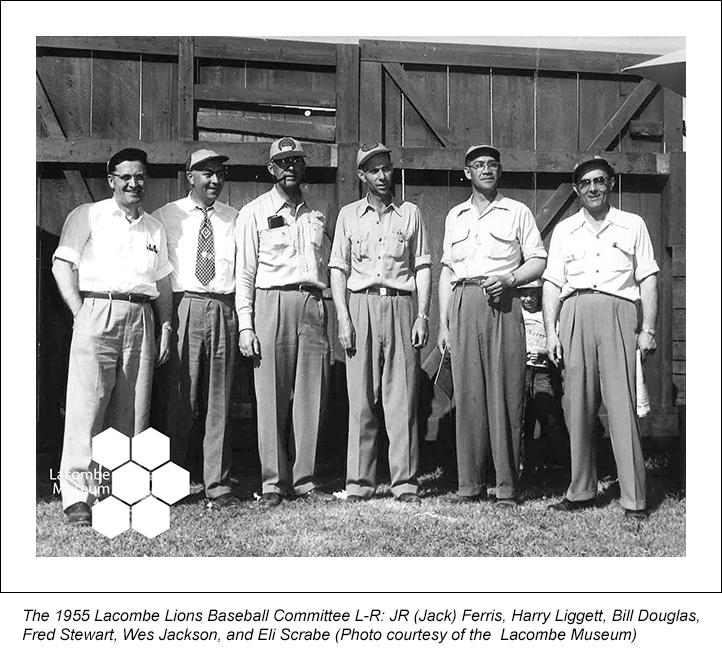
1951
In ’51, the Sports Mill columnist Don Fleming reports, "The Lacombe ball tournament is here to stay...The local Lions who have done such a magnificent job of putting the thing over in two short years, despite a few obstacles like weather and late seeding, figure they are over the hump...Harry Leggett, chairman of the baseball committee of the service club this year, admitted with a relieved smile that they cracked the $4,000 nut...He estimates that they cleared the mark by two grand...A big chunk of this profit will be plowed back into their baseball venture...They intend to make Lacombe renowned for its baseball tournaments....” (Edmonton Journal, 11 June 1951, Pg. 9)
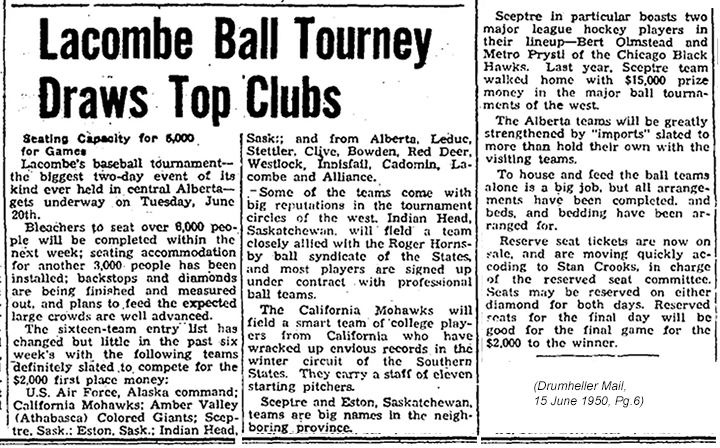
 By May, the eight competing teams and the prize breakdowns were announced: Sceptre, Swift Current Indians, Indian Head Rockets, California Medicine Hat Mohawks, Standard, Morinville, Edmonton Oilers, and Kinsmen Central Alberta All-Stars. “The winning team will receive $1,400. Second Prize $700, third $400 and fourth $350. Each of the remaining four teams will receive a $200 guarantee after they have played one game.” (The Calgary Albertan, 28 May 1951, Pg. 11)
By May, the eight competing teams and the prize breakdowns were announced: Sceptre, Swift Current Indians, Indian Head Rockets, California Medicine Hat Mohawks, Standard, Morinville, Edmonton Oilers, and Kinsmen Central Alberta All-Stars. “The winning team will receive $1,400. Second Prize $700, third $400 and fourth $350. Each of the remaining four teams will receive a $200 guarantee after they have played one game.” (The Calgary Albertan, 28 May 1951, Pg. 11)
The Calgary Albertan reports that the Lacombe fairgrounds, located by the agricultural research station, are ready for 8,000 fans to walk and sit on the bleachers and seats along the field's line. The community has stepped up to help accommodate all these visitors by offering rooms in their households. It’s reported that the CBC will be broadcasting the games. ((Lethbridge Herald 05 June 1951, pg. 10)
It was a group of young college kids from California, the Medicine Hat Mohawks, that swept the tournament and beat the more seasoned teams and players, which included Negro League pitcher Chet Brewer and hockey linemate of Maurice ‘The Rocket’ Richard, Bert Olmstead, who played for Sceptre. Morinville also recruited Americans to play on their team, including major leaguer Jeff Heath, outfielder (who was born in Canada). Heath played most of his career with the Cleveland Indians. (Lethbridge Herald 05 June 1951, pg. 10)
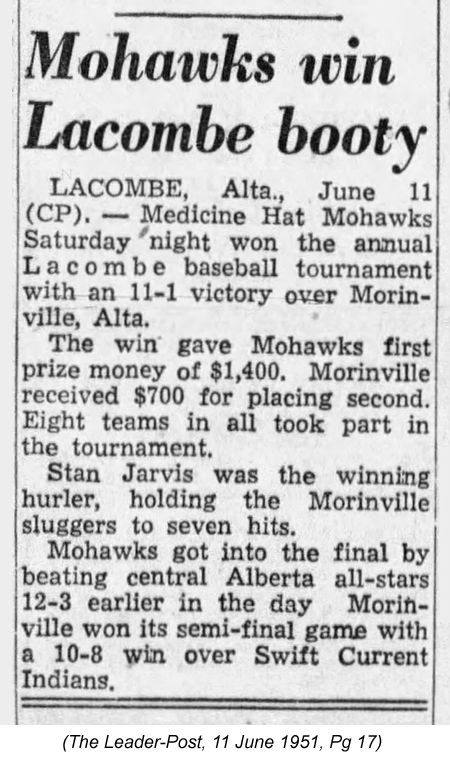
After its second year, the 1951 Lacombe ball tournament showcased remarkable talent and solidified the town’s reputation as a baseball hub. The success of the event underscored the tournament's growing prestige. The community’s unwavering support, from the meticulous preparation of the fairgrounds to the hospitality extended to visitors, played a crucial role in this achievement. With substantial profits reinvested into the event, the Lacombe Lions determination to make its baseball tournaments renowned is clear. The foundation laid in 1951 promises an even brighter future, ensuring the tournament remains a staple in the community and province.
1952
There is a saying on the prairies, “Nothing brings people together like the weather” (to talk about it and, if outside, sends them running for cover), and it plays a huge role in how profitable or unprofitable this event could be—up to a $10,000 licking, as reported by Fleming.
Huge improvements were being made to the park, such as adding a new nine-foot fence, which cost $2,000, and the Lions again offered a substantial prize of $3,250. Plans to create a ball diamond superior to any in Western Canada were in the works, such as adding lights to give “our fans a lot of high-class baseball that they wouldn’t otherwise be getting.” (Edmonton Journal, 21 Jun 1952, Pg 12)
By June 11th, the Red Deer Advocate announces the eight participating clubs have paid their $100 entry fee: Central Alberta All-Stars, Indian Head Rockets, Cuban-All Stars, Morinville, Great Falls Air Base, Leduc Oilers, Brooks Buffaloes, and Edmonton All-Stars (Red Deer Advocate, 11 June 1952, Pg 3). On June 21st, the first-round bracket draw will be made in the banquet room of Gerry White’s Lacombe Hotel at 10 a.m. Monday, the public is invited to sit in.
Bill Douglas and Fred Steward, tournament co-chairs, are hoping for a good growing season for farmers because good crops mean that farmers have more free time to come and watch the games: “The crop is already in for 1952, and what’s left of last year’s crop is off. We’ve had enough moisture to make the farmer’s happy, and we’re expecting that the boys to the south and southeast, especially will be flocking in”
However, good crops could mean more rain, which isn’t good for the ball diamonds. The Lions have easily prepared for this by having gasoline on hand. Pouring gasoline and igniting it was a way to burn the water off quickly, a practice that is thankfully banned today. (Edmonton Journal, 23 June 1952, Pg 8)
Gordon Sweet is seeing merchandise fly out of his store, a positive sign for high attendance at the tournament: “...Gordon Sweet, the drugstore man and publicity agent for the Lacombe tournament, reports that 12 dozen baseball caps done in Lions colors of gold and blue were ordered and snapped up within 10 days...In our opinion the baseball fever, particularly with respect to tournaments, is at an all-time high, enthuses Gord.” (Edmonton Journal, 21 Jun 1952, Pg 12)
This fever spilled over into newspapers predicting who would be this year’s champions:
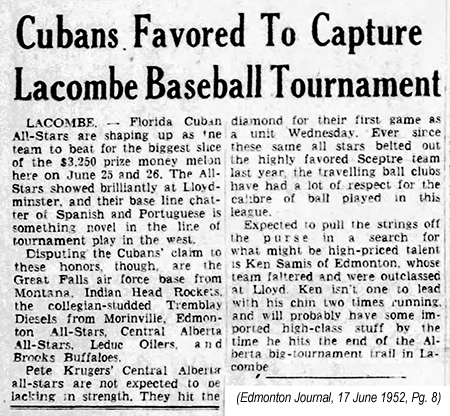
That is a good prediction; 9,000 fans watched over the two-day tournament as the Cuban All- Stars beat the Leduc Oilers in the final: “The Florida Cuban All-Stars took top prize money at the $3,250 Lacombe Baseball Tournament with a 13-2 trouncing of Leduc Oilers in the final. Cubans exploded for eight runs in the 2nd inning and cruised to the victory. Juan Dominguez went the distance for the win pitching a three-hitter. Oilers reached the final with a 7-6 win over the Great Falls, Montana, AirLifters while the Cubans downed the Edmonton All- Stars 7-4.” (attheplate.com)
 The 1952 Lacombe Baseball Tournament epitomized the spirit and passion for baseball within the community, despite the ever-present challenges posed by the weather. Significant investments, such as the new nine-foot fence and plans for enhanced ballpark lighting, underscored the commitment to elevating the tournament's prestige. The diverse roster of participating teams and the enthusiastic public response, as evidenced by the rapid sale of Lions- colored baseball caps, showcased the tournament's broad appeal and local support.
The 1952 Lacombe Baseball Tournament epitomized the spirit and passion for baseball within the community, despite the ever-present challenges posed by the weather. Significant investments, such as the new nine-foot fence and plans for enhanced ballpark lighting, underscored the commitment to elevating the tournament's prestige. The diverse roster of participating teams and the enthusiastic public response, as evidenced by the rapid sale of Lions- colored baseball caps, showcased the tournament's broad appeal and local support.
1953 – “Best Tourney so Far”
According to the Edmonton Journal, the third year of the Lacombe tournament "boasted everything a tourney could want – including rhubarbs galore" (Edmonton Journal, 27 Jun 1953, Pg. 18). The Delisle Gems' Max, Doug, and Bev Bentley, nicknamed the "Delisle Debating Society" by fans, were vocal about their dissatisfaction with umpire Lefty Mack's calls and ended up in third place, taking home the $400 prize.
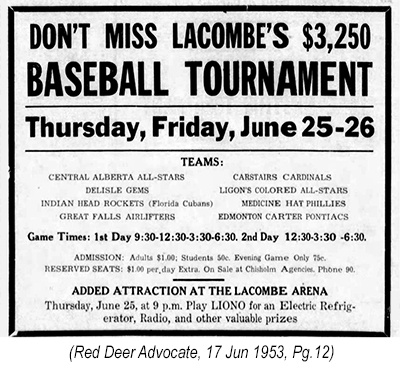
While the Bentleys continued their disputes in the background, attention shifted to the thrilling performances of the African American and Afro-Latino teams: George Ligon’s Colored All- Stars and the Indian Head Rockets, who had barnstormed as the Florida Cubans in 1952.
Seventeen-year-old Ivory Long stood out by pitching a no-hitter as George Ligon's Negro All- Stars defeated the Central Alberta All-Stars 6-0. The All-Stars, based in Prince Albert, claimed the first prize of $1,400 with a 9-2 victory over the Indian Head Rockets, highlighted by crucial home runs from Percy Howard and William Washington.
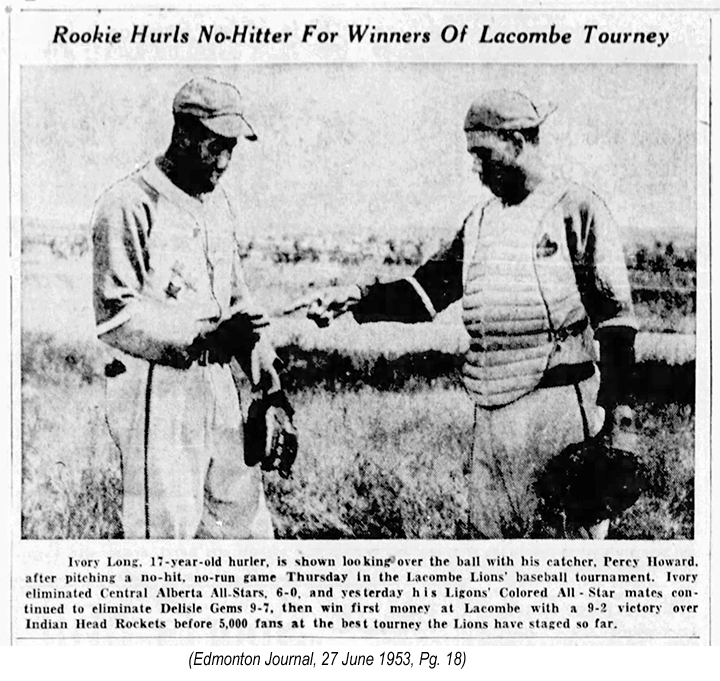
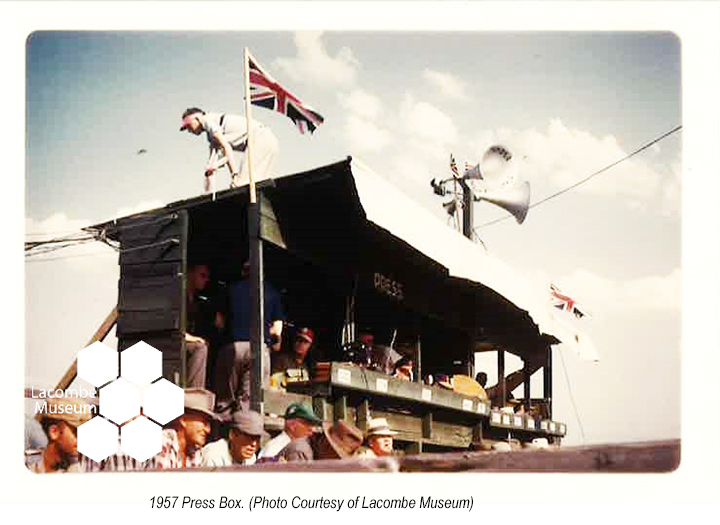
The 1960s, Beyond Shattering records and attracting major league scouts,
cementing its legacy as a prairie baseball tradition
By 1960, the 10th annual tournament saw all records shattered as Slim Thorpe's Lloydminster Meridians dominated, drawing a record 10,000 fans over two days and defeating the North Alberta All-Stars 27-5 in a final that ended early due to darkness. The Meridians' stellar performances, including those by Tom Bergeron and Curly Williams, and their 25-hit game in the final, led them to a decisive victory and the $1,500 top prize, marking the most one-sided final in the tournament's history.
As the Lacombe Tournaments continued flourishing, the growing excitement and high level of play attracted significant attention from major league scouts. These scouts were a constant presence, diligently searching for emerging talent and evaluating players who exhibited potential to advance to the next level. They brought a discerning eye and a detailed checklist of attributes they sought in prospective stars, further elevating the tournament's prestige and competitive spirit.
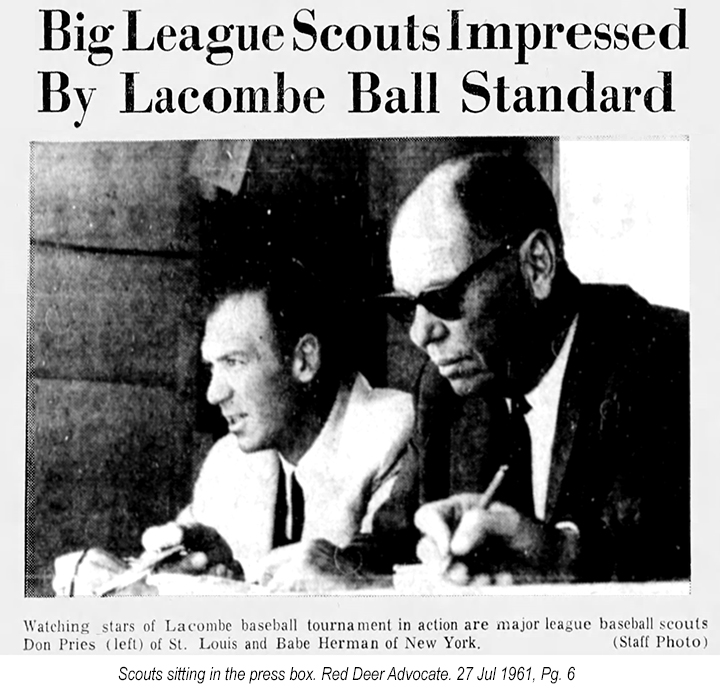
St. Louis Cardinal scout Don Pries’ checklist when looking for that next big talent was very specific: “I like to sign them between the ages of 18 and 21. If a player is a real prospect, I may sign him at 22. But that is the limit. You have to figure that they will spend four or five years in the minors before move up to the major leagues. If a man is 27 when he starts with a major league team he hasn’t got too many top years left.”
Writing in 1979, columnist Terry Jones shared his love for the tournament and how it kept semi- professional baseball alive on the prairies for so many years:
“It’s a love affair not only with the people in the press box but with the usual 3,500 fans who trek here from throughout the northwest every year. To people who have never been here, I’m sure this is just another ball tournament. But to the people who come every year, it’s far more than than that, it’s a tradition.
They sit in the stands here every year, and they talk about the same things. This tournament is as much the past as it is the present. That’s the attraction... ...
Ralph Vold of Ponoka pitched the first game of the first Lacombe baseball tournament. He was discovered here and ended up with a career in the Brooklyn Dodgers and the New York Giants organizations.
It all happened right here, he said. Lacombe was responsible for the best years of my life. To be able to play briefly with Jackie Robinson and Sandy Koufax and to go to all those training camps in Florida and to play in the Global World series in 1957 in Briggs Stadium in Detroit was all the result of Lacombe.” (Edmonton Journal, 27 July 1979, Pg. 57)
Conclusion
Despite its modest size of just 2,200 people in the 1950s, Lacombe played a significant role in the Western Canadian baseball scene. Known today for its agricultural research station, Lacombe's rich history includes hosting some of the most impressive baseball tournaments in the region nearly 75 years ago.
These tournaments drew teams from across North America and attracted MLB scouts hunting for emerging talent. Organized by the Lacombe Lions Club, the annual event became a highly anticipated spectacle, boasting large crowds and significant prize money. The tournament's success, however, waned after 39 years when it was put on hold, awaiting a new venue after the construction of a local junior high school on the original ballpark site. Lacombe’s early tournaments, supported by a passionate community, laid the groundwork for modern baseball competitions in Canada, highlighting the town’s pivotal role in the sport’s regional development. Columnist Danny Rode shared final thoughts on the Lacombe tournament:
“Like Bill Douglas, who has been involved, in one way or another, in all 39 years of the tournament. He can feel proud of what he, and scores of others like him, have given the town of Lacombe and baseball in general.
Proud of the fact they’ve given us all a little piece of Canadian Baseball History. Maybe, just maybe, there could be a little area in the Canadian Baseball Hall of Fame for a pioneer, a tradition. The Lacombe Lions baseball tournament should be enshrined forever in Canadian folklore.” (Danny Rode Column, Red Deer Advocate. 21 Jun 1988, Pg. 6)
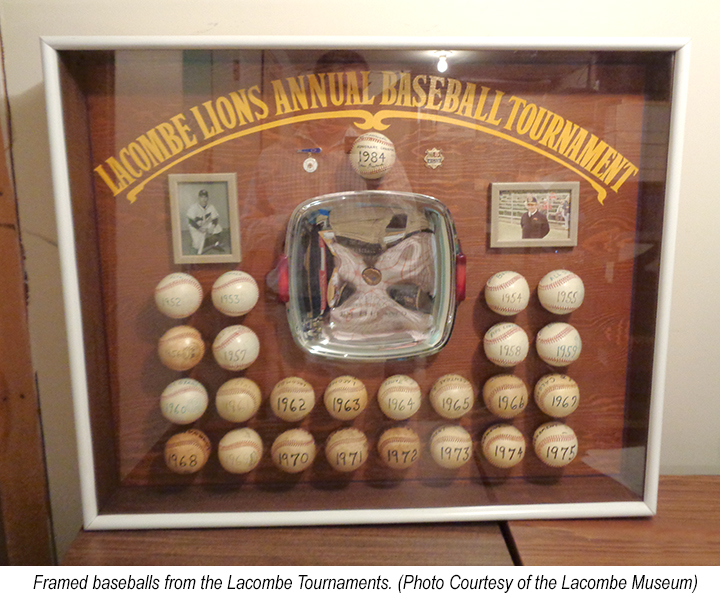
Thank You
Thank you to Brittany Kerik, Collections Registrar and Researcher at the Lacombe Museum, for researching their archives on my behalf and finding some beautiful photos and ephemera. Thank you to Jay-Dell Mah for asking me to write an article for the Lacombe Tournament; learning about this significant piece of prairie baseball history was an absolute pleasure.
About

Robyn Jensen is a storyteller, baseball historian, curator, and artist who has lived in the community of Indian Head, SK, for almost 20 years.
Her involvement in the local museum led her to research and create an exhibit for The Indian Head Rockets (All African American and Cuban Baseball Teams 1950-54). Inspired by that work, she returned to university for a master’s in media and artistic research - museum curation. Needing an outlet to share the additional stories she uncovered along the way; she created a blog called Home Runs & Dirt Roads – Stories of Baseball in Saskatchewan (homerunsdirtroads.ca)
